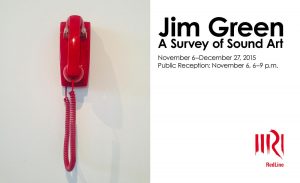
Redline is a non-profit contemporary art center located at 2350 Arapahoe St.
From the outside, this place may look like just an art gallery, but if you step inside and wander around, you’ll soon discover that Redline is an incredible non-profit contemporary art center dedicated to cultivating community and social change through art. Admission to Redline is free, so go ahead and check it out. You’ll discover thought-provoking contemporary art in an airy gallery space; more than a dozen artist studios where you are invited to peek in and see artwork being created; and a community studio space where artists of all ages meet at a variety of times during the week for classes and open studio time. If at the end of your visit, you’ve enjoyed your experience and want to support the wonderful things Redline does for the community (both artists and everyone else) then make a donation of $5 at the desk!

A view of Redline’s gallery space with open studio doors visible along the far wall.
5 Things We Love About Redline
- A space for artists and the public to connect. When was the last time you had the opportunity to see art in process? Redline gives visitors the chance to see art being created and to engage with artists about their process, their vision and their work. How does this
Artist-in-residence, Ramon Bonilla.
happen? Redline’s artist in residence program gives selected artists free studio space at the gallery so it’s easy to connect with artists as their studios are onsite and the doors are always open. Redline also brings artists into the community through a variety of programs.
- Support for emerging artists through their Artist in Residence program. The artist-in residence program at Redline is so inspiring. Not only are do the selected artists (it’s an audition process with hundreds of applicants each year from our region and beyond) given a free studio space, but they also receive mentorship, support from a community of likeminded artists and opportunities to promote their work. As part of their residency, these artists participate in Redline’s many community programs.
- Opportunities for artists of all ages. Redline offers art classes for kids as young as 2 years old and weekly non-instructive figure workshops for adult artists of all media for just $10. RedLine’s Educational Partnership Initiative for the Creative (EPIC) Arts program connects RedLine resident artists with educators from Denver area K-12 schools to implement curriculum that inspires students to create artwork through a lens of contemporary social justice.
- Opportunities for artists from all backgrounds. Redline’s Reach Studio is a free, open
and supportive arts studio space where artists in Denver’s “not exactly” homeless and in-transition community can come to express themselves creatively, be exposed to new art forms, collaborate with peers, learn new skills and challenge each other to take the next step in their art, and in their lives. Redline helps Reach Studio artists sell their work and even secure scholarships to attend art school.
- Engaging and friendly programming. From Redline’s well-curated, ever-changing gallery shows, to its playful and quirky evening events like Ménage à Trois and 1SQFT (10/30), Redline is a great place to explore contemporary art even if you don’t know anything about the subject. This is a community art space that strives to make everyone feel comfortable and welcome and they certainly do!
Location: 2350 Arapahoe St.
Hours: TUE – SUN, 11a – 5p
Admission: Suggested donation of $5 for adults; $3 for students
Website: http://redlineart.org
A Deeper Look at Redline’s Artists in Residence Program
Redline’s Artist in Residence program engages approximately 10-15 artists at any given time who remain “in residence” for a two year period. Artists receive free studio space at Redline, plus professional development, mentoring, and exhibition opportunities as part of their residency. In speaking with some of the artists currently in residence, it became clear how much they appreciate the opportunity to work in a community space with other artists who are also dedicated and focused on developing their work. Also high on most artist’s list was the ample size of the Redline studio spaces and the fact that they are fully subsidized. Denver studio spaces can be difficult to find and expensive. Walking from studio to studio, one easily notices that there’s no one way to be an artist; each studio space is so different from another. The spaces are all labeled with the artist’s name, so it’s easy to figure out whose artwork you’ve just fallen in love with.

Artist-in-residence, Sandra Fettingis at work creating a mural in her studio space at Redline.
Q: Can I really peek inside the artists’ studios and chat with them?
A: Yes! You really are invited to do this! Artist-in-residence, George Perez, explains that engaging with the public and explaining his work is part of growing as an artist and learning to be an effective communicator. He says, “it’s nice to practice talking about my art with people who come by.” Artist-in-residence, Sarah Rockett comments that “in the contemporary time, we have so much accessibility with the internet, yet it’s important for artists to be even more involved and even invite people into their studios” in order to make authentic connections with their audience.
Meet the Current Artists in Residence — And Then Go Say Hi in Person!
RAMON BONILLA – “The influences of Ramón’s work range from topography to the architectonic artifice and from mapping to vector graphics. Furthermore, his artwork is influenced by the lay of the land of his Caribbean country of origin as well as by his ramblings with his wife through parts of the U.S. and Canada. Rather than an attempt at representation, Ramón’s simulated environments which are devoid of any concerns with identity or history, act as an after-image of our ever growing number of transient surroundings.” – Artist Statement













Upcoming Exhibition: Greenscapes: A Survey of Sound Art by Jim Green





